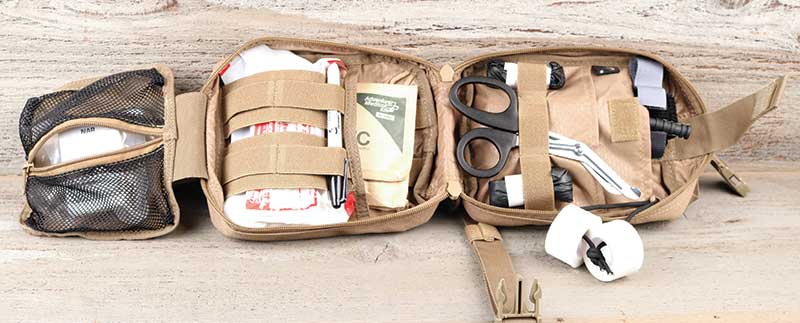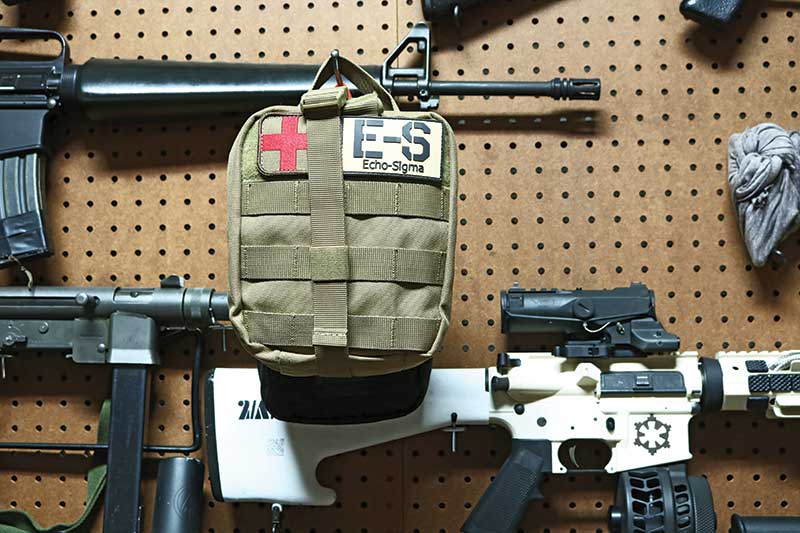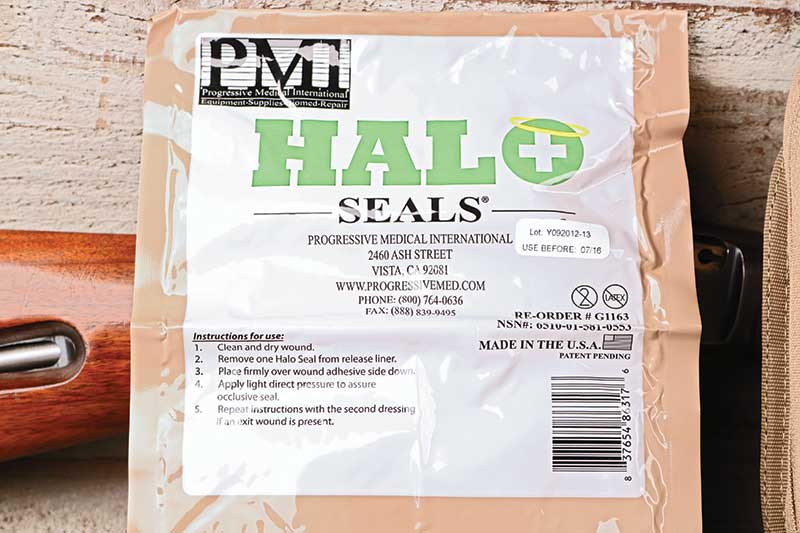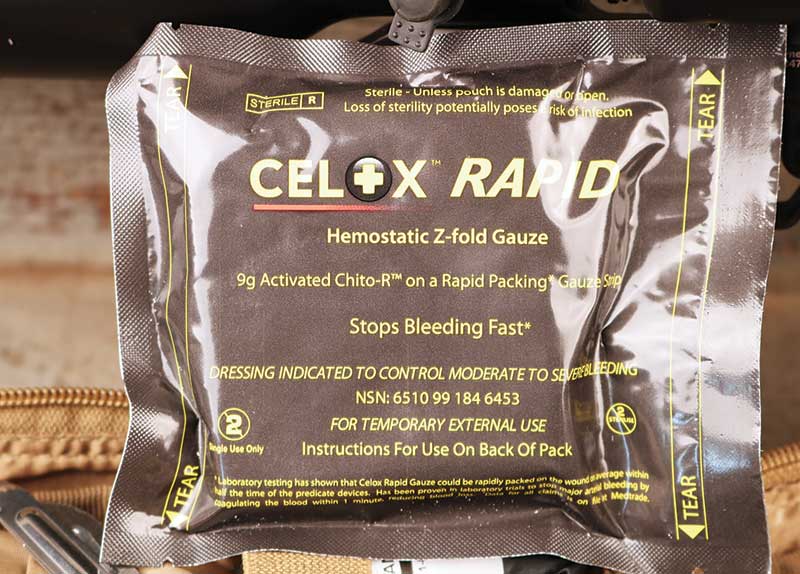First Aid
Knowing How To Cope With Emergency
Situations Can Save A Life
The man and his adult son had burned a pleasant afternoon deer hunting but came up empty. Their deer stands were maybe a half-mile apart, and the plan was to rendezvous at dusk at the son’s stand and then walk out of the woods together. As the light got slim the son heard movement in some nearby brush and trained his 7mm Magnum towards the sound. He saw a flash of brown through the scope and squeezed the trigger.
The 150-grain expanding bullet struck the man’s dad at the base of his penis and exited through his rectum. The resulting wound would’ve accommodated a mature orange. Multiple surgeries restored much of the victim’s functionality but the fact he survived is legitimately miraculous.
Hunting large game means using tools mechanically optimized to take life. Our weapons, cartridges, and bullets reflect the state of the art in engineering and metallurgy. The mission is to drop game cleanly so the transition from forest to dinner table is no messier than it needs to be. An unfortunate side effect is these tools can be incredibly dangerous.
The first recorded use of an aircraft to medically evacuate a wounded combatant was in the Sinai in 1917. A British soldier wounded in the ankle was evacuated via a 45-minute flight to treatment facilities. The same trek by land would have required three days. In the Second World War, many died simply because the technology was not available to medevac soldiers in a timely fashion. By the time we were engaged in Vietnam the widespread use of the helicopter combined with pushing portable medical support facilities close to the action changed the equation dramatically. In Afghanistan today the average time from injury to operating theater is 42 minutes.
Survival rates drop off precipitously when it takes more than an hour to get to proper medical care. Nowadays spinoff technologies from the military provide lifesaving gear to buy more time to transport a wounded hunter to a hospital. Such gear is easy to use, lightweight, safe, and fairly inexpensive. Echo-Sigma’s basic combat trauma kit is sufficiently lightweight and compact to keep you company every time you hit the field.

The Echo-Sigma Trauma Kit is logically arrayed and well reasoned. The Condor pouch folds open easily so everything is
readily accessed. This kit includes enough basic trauma management gear to stabilize most common hunting injuries in a
field setting. The intent of this gear is to buy enough time to transport a patient to appropriate medical facilities for definitive treatment.
Exsanguination
Two friends were hunting deer and the light was failing. One of the two packed his climbing stand on his back and headed out to meet his buddy for some company during the walk back to the pickup. The man’s friend heard brush breaking and mistook the support structure of the stand for antlers in the dim light. His round severed a large artery and his friend subsequently died from blood loss.
Aside from mechanical disruption of the central nervous system, blood loss is the most lethal mechanism in gunshot wounds. A typical adult male carries 5 liters of blood onboard—two-and-one-half 2-liter coke bottles. Lose a liter of that in 20 minutes and you lose effectiveness. Make that 2 liters in the same time period and it can be lethal. Managing hemorrhage is frequently the single most important thing you can do for somebody with a gunshot wound. Fortunately, there are some innovative products to help manage such stuff.
Clot enhancers like Celox add additional clotting power to the body’s natural clotting systems. Synthesized from highly refined shrimp shells, Celox comes in granulated form as well as impregnated bandages. Once applied, a material called Chitosan swells and gels to help staunch bleeding. The surgeon will take care of getting rid of it later. Chitosan is a form of sugar and is physiologically harmless. Celox has been employed in combat and is both easy to use and remarkably safe.
A news item came out the week before I drafted this article concerning a soldier wounded in combat whose life was saved by the use of clot enhancing sponges injected directly into a wound. This sort of technology is advancing rapidly and spills over into the commercial sector almost as soon as it arrives in the medical kits of our Special Forces medics.

The Echo-Sigma Trauma Kit is compact and easy to carry. This reasonably priced kit includes most of the gear you might
need to manage traumatic injury in the field. A basic trauma kit need not be heavy, bulky, or expensive. If properly executed
such a kit can easily become a part of your standard hunting loadout.
Tourniquets
The young man was 24-years old and had an otherwise-unremarkable 1-inch laceration to the inside of his right elbow. He worked construction and had cut the steel strapping off of a cube of bricks only to have the steel snap back and pop him like a snake. His buddies tied a pair of tourniquets around his upper arm and drove him to my urgent care clinic with his entire arm wrapped in a towel. He had already lost a great deal of blood before we met.
The young man falsely assumed because he was in a doctor’s office all risk had passed. Before I could stop him he dropped the towel and removed the two tourniquets. The laceration had split the median cubital vein, the large-bore piece of plumbing from which phlebotomists commonly draw your blood. The resulting crimson torrent was not unlike that of a garden hose.
The man lost consciousness immediately and nearly bled out in my clinic before I could tie off the bleeder and get the wound closed. The moral here is a proper tourniquet properly used can be a lifesaver. However, screw up the details and you can make a bad situation worse.
A tight tourniquet can easily result in loss of a limb. Use this device when the probability of death outweighs the possibility of catastrophic limb damage, or you just need to buy a little time to get to a proper medical facility. The tourniquet included in the Echo-Sigma trauma kit is easy to use but you should practice with it a bit before taking it to the field. The time to figure out how something works is in the comfort of your home, not in the field after things go sideways.
Chest Trauma
The young man parked at his hunting club alone in the predawn darkness, his loaded .50-caliber muzzleloader stashed in the back of his vehicle. Grabbing the gun by the muzzle he pulled it out the back of his jeep. The hammer caught on a seat spring and retracted far enough to fire but not far enough to catch the sear. The .50-caliber patched ball struck the kid in the right chest from a slant range of about 8 inches.
The ball exited his back along with a 4-inch chunk of rib found the following day by investigators. Despite several periods of involuntary unconsciousness the young man somehow managed to drive 30 minutes to medical care. With some aggressive and timely intervention he ultimately survived.
Occlusive dressings called chest seals are fairly easy to use and effective for sealing penetrating chest trauma. Closing holes can help keep lungs from collapsing precipitously and potentially buy some time to get to a hospital. These handy tools are designed to make an airtight seal on human skin despite the inevitable blood and gore. Keep in mind you will typically need two! Most entrance wounds have a corresponding exit wound. You can find chest seals at Bound Tree Medical.
Echo-Sigma is a respected supplier of survival gear to both government and civilian users. Their basic trauma kit is reasonably priced and fairly painless to carry. I added some inexpensive chest seals and a set of hemostats to mine but the kit is remarkably capable straight from the company.
The Echo-Sigma kit includes a combat tourniquet, Celox hemostatic gauze, a 6-inch emergency trauma dressing, compressed gauze, tape, gloves, and shears. It also includes a sterile suture kit for use in truly desperate spaces. You will need to supply your own needle driver and lidocaine but if you feel up to the task all the other gear is there. If suturing is not your bag the kit is available with more basic first aid supplies in place of this component. The whole rig comes in a handy rip-away Condor EMT pouch with some extra space for medicines or ancillary stuff like chest seals.
I had some personal connection with each of these presented medical examples. Though adherence to proper safety rules would have prevented all of these accidents, basic medical survival training is readily available and could have made a difference in each. Many Community Colleges offer EMT training at times that accommodate a work schedule. Such skills can literally save lives when you find yourself deep in the suck.
It behooves all of us who enjoy the outdoors to acquire the gear and the skills to administer life-saving first aid to those around us who might become injured. The same stuff has applications to motor vehicle accidents and, sadly, episodes of workplace violence as well. Echo-Sigma has the gear and it won’t break the bank. Invest a little money and some forethought and you might just save somebody’s life.
Bound Tree Medical
P.O. Box 8023
Dublin, OH 43016
(800) 533-0523
www.boundtree.com
Echo-Sigma Emergency Systems
16022 Arminta St., Suite 6
Van Nuys, CA 91406
(424) 241-3246
www.echo-sigma.com
My Medic
120 N Redwood Rd,
North Salt Lake, UT 84054
MyMedic.com





